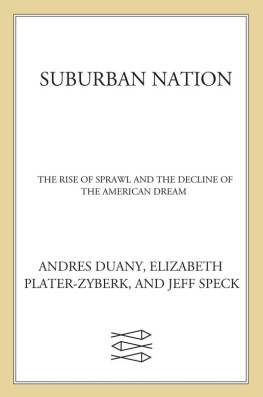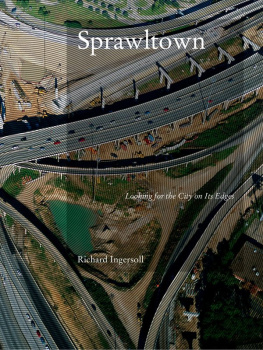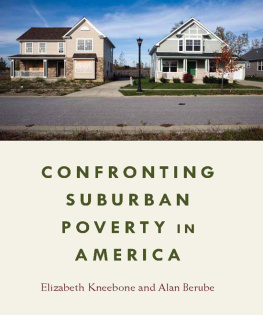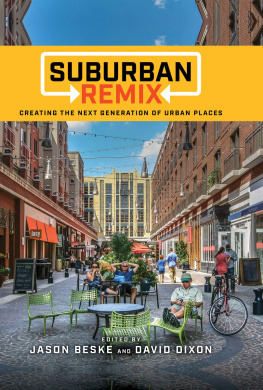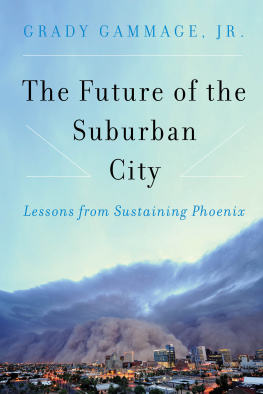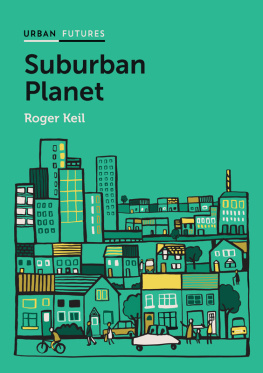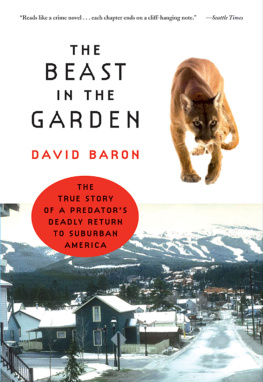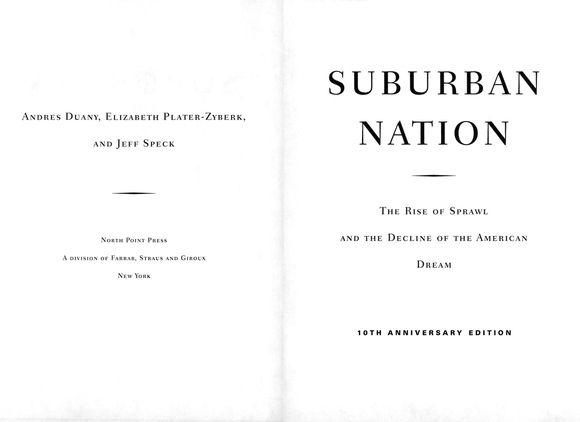THE STORY OF SUBURBAN NATION
Now that Suburban Nation has managed to stay in print for a decade and sell close to 100,000 copies, it seems excusable to tell the story of how it came to be.
I had been eagerly following the work of Andres Duany and Elizabeth Plater-Zyberk since their Neo-Constructivist Arquitectonica days, and had been intrigued and excited by their new town of Seaside as a design exercise, without considering its larger social implications. There is a note to be found in one of my pre-architecture school sketchbooks: If you are interested in urban design, find these guys. Then, in 1988, I heard Andres speak at the Museum of Fine Arts in Boston. It was what was to become his famous Town versus Sprawl lecture, and I immediately knew two things: first, that this was the best story I had ever heard; and second, that it had to be a book.
It was the best story I had ever heard because even though I had understood it in my heart for years, I had never understood it in my head. I knew that I loved older places like Georgetown and hated newer places like Tysons Corner, but I had never really asked myself why. Andres explained why, and he also explained how these beloved and unlovable places had come to be. He identified the villains andthe historical processes that had half destroyed the American landscape; and, remarkably, he showed us how we could fight those villains, reform those processes, and literally win back ground.
Around that time, I had recently published my first book and was considering moving to Rotterdam to work with Rem Koolhaas on what was to become S,M,L,XL. That offer never materialized and I started architecture school at Harvard, where my professors attitudes toward Duany Plater-Zyberk ranged from amused to hostile. Unswayed, I wrote a letter to Andres and Lizz, offering to ghostwrite a book that would bring their message to a larger audience. They never wrote back.
Four years of continued pestering led to no progress on that topic, but it did get me hired by Duany Plater-Zyberk & Company after graduation. Once firmly ensconced in Miami, I kept asking about the book, but there were always too many other things to get done. My challenge was to convince Andres and Lizz that a book, far from being a distraction, could make our jobs easier.
I had always been amazed by Andress and Lizzs patience with the Sisyphean task of convincing American communities to make traditional town planning legal again. It seemed that we repeated the same experience every month: we would show up in a city or town; meet with every willing citizen and public official; explain over and over, often encountering great resistance, why streets were too wide, trees were too scarce, and diverse land uses were kept too far apart. More often than not, we would get somewherenever as far as we wanted, but after weeks of meetings and months of drawing, we would reach a compromise that led to skinnier streets, more trees, and a healthier mix of uses. Then, the next month, we would arrive in another community, begin the process again, and be met bythe same resistance, as if we had never accomplished anything. Werent you people listening? I would silently curse. Then I would remember that we were no longer in Madison; this time we were in Santa Fe and no, the conversation was just starting. All over again.
The desire to short-circuit this Groundhog Day situation finally drove Andres and Lizz, in 1998, to let me write a first draft. Andress Town versus Sprawl lecture became the heart of the book, supplemented by another lecture he had developed in 1992, The Story of City Planning, a fast, loose, and mostly true yarn about the glorious past and ignominious present of the planning profession. A final chapter, What Is to Be Done, grew out of a characteristically insightful paper by Lizz. These three sources were augmented by roughly five years spent reading the publications now listed in the bibliography, most of which could be found in the formidable DPZ office library.
The greatest struggle, from a literary perspective, was translating Andress distinctive voice into print. Direct transcriptions of his lectures, which seemed so clear and compelling in person, produced something other than English. I consider this voice to be an essential aspect of the books popularity, just as the New Urbanism movement can credit much of its ascendancy to Andress charisma and sense of humor. Most of the jokes in the book are his, not mineat least the good ones.
I think it is safe to say that Andres and Lizz, who are not known for lacking confidence, were nonetheless surprised by the early and continued success of the book. It is often difficult to fathom the merit of ones own ideas. Furthermore, my coauthors had grown accustomed to the cynical gaze of the design world, until recently one of the most out-of-touch and disoriented intellectual communitiesin existence. Andres and Lizz had seen their efforts and their projects attacked for, among other things, their very populism and accessibility. No wonder, then, that what academia found to be too real-world, the real world was ready to hear and embrace.
As the following two essays relate, much has changed in the decade since Suburban Nation was published. In professional and policy circles, its arguments have mostly won the day. Even the most intellectually isolationist design schools are beginning to embrace the books activist message, as todays students are demanding a return to socially relevant work. Our most recent book, The Smart Growth Manual, puts meat on the bones of many of the issues raised here, for those who want to take theory into practice.
But many people still need convincing, especially on the (suburban) fringes. Lets face it: most Americans, who dont think very often about city planning and who havent been offered the alternatives, are still settling for sprawl. Turning that ship around is a project for the next decade.
JEFF SPECK, WASHINGTON, D.C.
RECENT DEVELOPMENTS
The ten years since Suburban Nation was published have seen a great change in American attitudes toward the built environment. Suburban Nation has not been the sole agent of this change, of course, but clearly we got something rightright enough for the book to have a shelf life and a future.
A predicated future suggests that the problems described herein remain. Still, one can be encouraged by visible progress. The alternativesto sprawl are clear, and examples abound. In once-decanted downtowns, empty parking lots are being replaced by streets and blocks of high-density housing, offices, and retail development. Mixed-use, transit , and walking are words that no longer elicit smirks. Indeed, in cities where public transportation was shunned, the lack of it is now a public complaint. The relationship between public health and the design of the built environment has been firmly established, with scientific data supporting the benefits of urban walking as part of a daily routine.
Many organizations have sprung up to promote this change. Among them, the Congress for the New Urbanism, by setting out principles for regional, neighborhood, street, and block design, has influenced many town plans, as well as national standards for traffic engineering. The U.S. Green Building Council has moved beyond rating individual buildings to include entire communities in its new LEED for Neighborhood Development program. Smart Growth America has consolidated environmental and urban agendas to promote compact development. Its arguments for the appropriate detailing of streets and buildings to make dense environments walkable have led to the Form-Based Codes Institutes influential advocacy. The Council for European Urbanism, the Institute for Traditional Building, Architecture and Urbanism, and other sister organizations in Australia, Israel, the Philippines, and India are globalizing shared principles and experiences.

